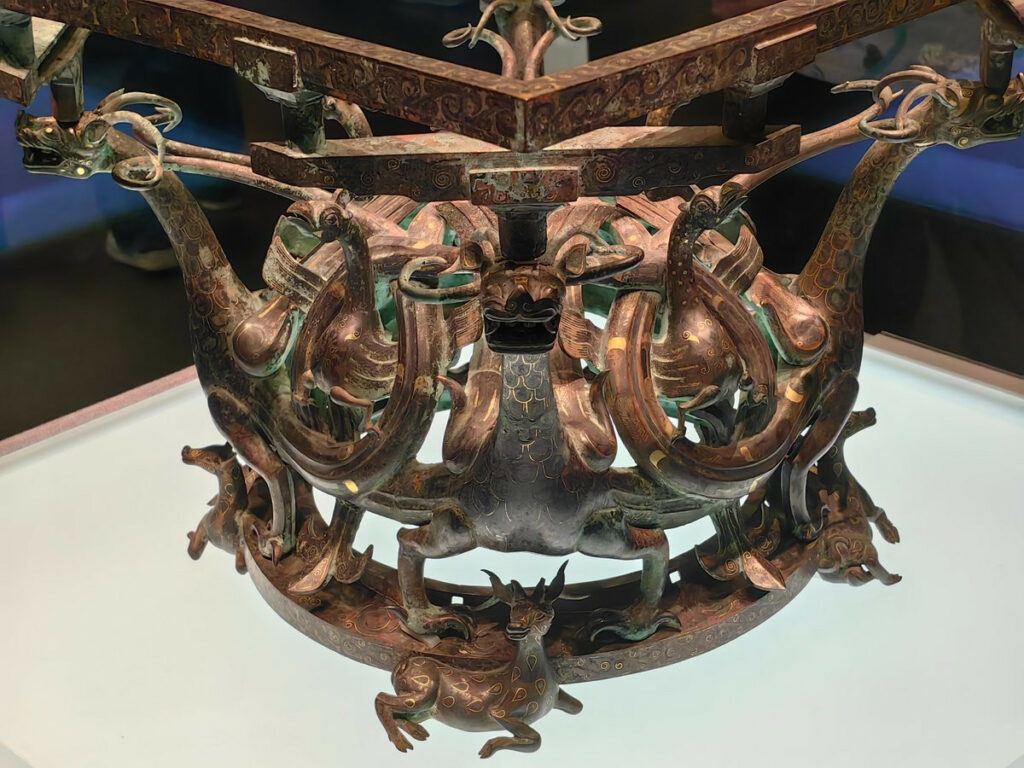The Discovery That Shook the Archaeological World
In the annals of archaeological discoveries, few artifacts capture the imagination quite like the bronze table frame unearthed from the tomb of King Cuo of Zhongshan. This exquisite piece, dating back to the Warring States period in China, offers a glimpse into a world of artistic brilliance and technological prowess.

In 1977, archaeologists working in China’s Hebei province made groundbreaking discovery. Hidden within the tomb of King Cuo, who ruled from 327 to 309 BC, lay a bronze table frame of unparalleled beauty. Measuring 76.5 cm in length and 45.5 cm in width, this masterpiece was adorned with intricate gold and silver inlays, depicting four dragons and four phoenixes – powerful symbols in Chinese mythology.
The discovery of this remarkable artifact sent shockwaves through the archaeological community, as it revealed the remarkable craftsmanship and artistic sophistication of the Warring States period in China. The tomb of King Cuo had been untouched for over 2,000 years, and the preservation of the bronze table frame was a testament to the skill and care of the artisans who created it.
Craftsmanship Beyond Compare
The artisans who created this piece demonstrated an extraordinary mastery of metalworking techniques. The seamless integration of gold and silver inlays into the bronze surface speaks volumes about their skill and attention to detail. Every curve, every line of the mythical creatures was rendered with precision, creating a harmonious blend of form and function.

The level of craftsmanship displayed in the bronze table frame is truly remarkable, even by today’s standards. The intricate patterns and designs, the delicate balance of the various elements, and the overall aesthetic beauty of the piece all testify to the exceptional skill and artistry of the Warring States period metalworkers.
What makes this artifact even more impressive is the fact that it was created during a tumultuous period in Chinese history, when the country was divided into numerous warring states vying for power and dominance. Despite the political upheaval, the artisans of the time were able to produce works of art that continue to captivate and inspire people centuries later.
A Window into the Warring States Period
This remarkable artifact provides invaluable insights into the cultural and political landscape of its time. Despite the constant power struggles that characterized the Warring States period, it was also an era of great artistic and cultural flourishing. The table frame, with its regal symbolism, stands as a testament to the wealth and power of the Zhongshan Kingdom.
The presence of the four dragons and four phoenixes, which were powerful symbols in Chinese mythology, suggests that the bronze table frame was likely used in important ceremonial or political events. The intricate designs and the high-quality materials used in its construction indicate that it was a prized possession, reserved for the elite members of the Zhongshan Kingdom.

By studying this artifact, historians and archaeologists can gain a deeper understanding of the social, political, and cultural dynamics of the Warring States period. The table frame provides a window into the lives and experiences of the people who lived during this tumultuous time, offering clues about their beliefs, their artistic sensibilities, and their aspirations.
Preserving History for Future Generations
Today, this magnificent piece resides in the Hebei Museum, where it continues to captivate visitors from around the world. Its exceptional state of preservation is a tribute to the dedication of researchers and conservators who have worked tirelessly to protect this priceless piece of history.
The bronze table frame from King Cuo’s tomb is not just a remarkable work of art; it is a tangible link to our past, a testament to the ingenuity and creativity of our ancestors. By preserving and studying this artifact, we can gain a deeper appreciation for the rich cultural heritage of China and the enduring legacy of the Warring States period.
As we continue to uncover treasures like King Cuo’s bronze table frame, we gain a deeper understanding of the human experience throughout history. These artifacts inspire us to explore the wonders that still await discovery in the rich tapestry of human history, and to appreciate the enduring power of art and culture to transcend the boundaries of time and space.

Conclusion
The bronze table frame from the tomb of King Cuo stands as a testament to the extraordinary artistic and technological achievements of the Warring States period in China. This exquisite artifact, with its intricate designs and masterful craftsmanship, offers a glimpse into a world of power, wealth, and cultural sophistication that has long since passed.
By preserving and studying this remarkable piece, we can gain a deeper appreciation for the ingenuity and creativity of our ancestors, and be inspired to continue exploring the rich cultural heritage of China and the world. The bronze table frame is not just a piece of history; it is a treasure that continues to captivate and inspire people from all walks of life, and a reminder of the enduring power of art and culture to connect us to our past and inspire us to create a better future.
